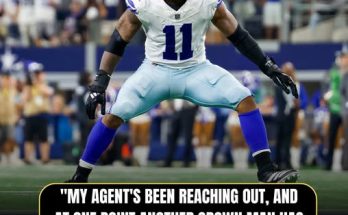In one of the most shocking moves of the NBA offseason, the Los Angeles Lakers have acquired All-Star forward Lauri Markkanen from the Utah Jazz in a stunning trade that sends fan-favorite Austin Reaves packing to Salt Lake City. The move, which seemingly came out of nowhere, has left fans, analysts, and even players across the league in a whirlwind of speculation, excitement, and disbelief. It was a trade that wasn’t on anyone’s radar just a few days ago, yet now, it could dramatically reshape the future of both franchises and send ripple effects across the entire Western Conference.
The Lakers, who have spent the past few years trying to rebuild around LeBron James and Anthony Davis while also maintaining cap flexibility and grooming young talent, just made a clear and decisive pivot. Markkanen, the 7-foot sharpshooting forward from Finland, brings a whole new dimension to the Lakers’ roster. He’s coming off the best two seasons of his career with the Jazz, having averaged over 23 points per game with efficient shooting splits and defensive versatility. At only 27 years old, Markkanen offers both star-level production and youth—two things the Lakers desperately needed as they stare down the final seasons of LeBron’s legendary career.
For the Jazz, the decision to part with Markkanen may seem odd on the surface. After all, he was their best player and was considered a potential long-term cornerstone. But Utah has clearly chosen to go all-in on a youth movement and long-term asset accumulation. In return for Markkanen, the Jazz are getting Austin Reaves, a gritty, versatile guard who quickly became a fan favorite in Los Angeles due to his heart, hustle, and knack for big plays in crucial moments. Reaves has proven himself to be more than just a role player—he’s a bona fide starter in the NBA and could flourish in Utah’s system with more ball-handling responsibilities and offensive freedom. According to league sources, the trade may also include future draft compensation or swaps to balance out value, but the principal pieces—Markkanen and Reaves—have already sent shockwaves through the league.
This is a classic case of two teams having completely different windows and needs. The Lakers are in “win-now” mode. With LeBron turning 41 during the 2025–26 season and his championship clock ticking loudly, there’s no time for patience or slow development. Markkanen gives them immediate firepower alongside Anthony Davis and LeBron, and crucially, he spaces the floor in ways Davis and James never could themselves. His ability to stretch defenses with elite three-point shooting opens up driving lanes, post-up opportunities, and transition mismatches. The fit is seamless on paper, and Darvin Ham now has a much more balanced offensive unit to deploy against the loaded Western Conference.
This also signals something deeper from Lakers management. For months, there have been whispers about whether the team would pursue a third star or remain patient with their current roster of emerging contributors. By making this bold move, Rob Pelinka and the Lakers front office have made their decision loud and clear: the time to contend is now, and no one is off-limits in pursuit of banner number 18. That includes Austin Reaves, who just a year ago was heralded as the future of the franchise’s backcourt. Reaves had chemistry with LeBron, he had a strong playoff résumé, and he had the trust of the coaching staff. But all of that wasn’t enough to prevent him from being moved when an elite frontcourt scorer became available.
It’s also worth examining why Utah made this move now. Despite Markkanen’s stellar play, the Jazz were not serious playoff threats. They’ve hovered near the Play-In line in a brutally competitive Western Conference, and with teams like the Thunder, Spurs, and Rockets rapidly improving, the Jazz risked being stuck in no-man’s land—too good to tank, not good enough to contend. Trading Markkanen while his value was at its peak gives Utah a chance to retool around a younger core. Reaves joins a group that includes Keyonte George, Taylor Hendricks, and Walker Kessler, giving Utah flexibility and a solid foundation for the next era of Jazz basketball.
For the league at large, this trade reorders the competitive landscape. The Lakers now have a modern frontcourt that combines size, skill, and athleticism. If they can stay healthy, a trio of LeBron, Davis, and Markkanen is capable of matching up with any team in the West. It gives the Lakers better floor spacing, allows Davis to roam more freely on defense, and lets LeBron conserve energy by playing more off-ball. If recent history is any indicator, health will be the biggest challenge, but if all three are available come playoff time, the Lakers are a legitimate title threat.
The move also spices up the ongoing rivalry between the Lakers and teams like the Denver Nuggets, Phoenix Suns, and Golden State Warriors. Denver’s size has overwhelmed L.A. in past playoff meetings, but Markkanen gives them a weapon to counter Nikola Jokić and Aaron Gordon more effectively. Against Phoenix, his range and size can stretch defenders like Kevin Durant and Jusuf Nurkić, while his rebounding prowess helps offset the Suns’ aggressive offense. And against Golden State, the spacing battle now becomes far more competitive.
Fans in Los Angeles are understandably torn. Reaves had become a cult hero in L.A. His scrappy playstyle and confidence under the bright lights of Crypto.com Arena made him a rare undrafted gem that Lakers fans rallied around. His departure marks the end of a feel-good chapter in Lakers lore, but fans who remember how Pau Gasol arrived or how the Lakers traded Eddie Jones for Glen Rice know that sometimes sentiment must give way to championship calculus.
Meanwhile, Utah fans are cautiously optimistic. While losing Markkanen hurts in the short term, Reaves is young, coachable, and plays with a chip on his shoulder. He fits the Utah mold of underdog overachievers, and if he develops further as a primary scorer and facilitator, he could become a franchise staple for years to come. The Jazz have also kept their powder dry in terms of cap space and draft picks, meaning they can still make other big moves down the line.
From a player perspective, Markkanen lands in a situation tailor-made for his skillset. Playing alongside two superstars should take some defensive pressure off him, and with LeBron’s passing ability, Markkanen will get more open looks than ever before. Reaves, on the other hand, gets the keys to a much younger, less structured offense. He’ll be encouraged to play freely, take risks, and expand his game beyond what he was able to do with LeBron dominating the ball.
What remains to be seen is how both players respond emotionally to the change. Reaves was very vocal about loving his time in L.A., and Markkanen had embraced his role as a leader in Utah. The abruptness of the deal might take time to process, but both players are pros who have adapted to change before. This is, after all, the NBA—where drama, movement, and reinvention are part of the brand.
In the coming weeks, training camps will open, media days will buzz with questions about the trade, and preseason rotations will give fans their first glimpse of how the new-look Lakers and reimagined Jazz take the floor. The trade might not have been on anyone’s bingo card, but the NBA is often at its most exciting when the unexpected happens.
Ultimately, this move underscores how razor-thin the line is between contention and complacency in today’s NBA. The Lakers weren’t content with simply running it back. They swung for the fences. Whether it ends in championship glory or serves as another what-could-have-been will depend on health, chemistry, and execution. But one thing is clear: the Lakers just changed the game. Again.


